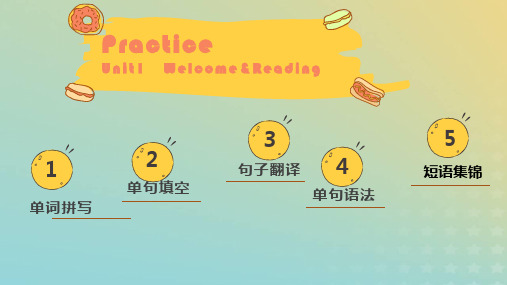高中英语复习专题课件
合集下载
人教版高中英语必修二:Unit+2+复习课件+(共15张PPT)

gymnastics, athletics, team sports and… 女性不仅被允许参加,而且她们还在体操、田径和 团队运动等比赛项目中起着非常重要的作用……
3.It's a great responsibility but also a great honour __to__b_e__c_h_o_s_e_n. 被选中不仅要承担巨大的责任,同时也 享有极大的荣誉。
法;魔术→magician n.魔术师
8.__r_e_g__u_l_a_r__ adj. 规则的;定期的;常规的
→regularly adv. 规则地;定期地;常规地
9._b__a_s__is__ n.基础;根据→basic adj. 基础的;
基本的
10.__a__d_m___i_t_ vt.& vi.容许;承认;接纳 →_a__d_m___i_s_s_i_o_n_ n.准许进入;承认;入场费 11.__s_l_a_v_e__n.奴隶→slavery n.奴隶制度
• 3、is not the filling of a pail but the lighting of a fire. • 4、好的教师是让学生发现真理,而不只是传授知识。
• 5、be unboun than untaught, for ignorance is the root of misfortune与其不受教育,不知不生,因为无知是不幸的根 源。
4.There's as much competition among countries to host the Olympics
as___t_o__w__in____Olympic medals.
国与国之间争取奥运会承办权的竞争就跟争 夺奥运奖牌一样激烈。
3.It's a great responsibility but also a great honour __to__b_e__c_h_o_s_e_n. 被选中不仅要承担巨大的责任,同时也 享有极大的荣誉。
法;魔术→magician n.魔术师
8.__r_e_g__u_l_a_r__ adj. 规则的;定期的;常规的
→regularly adv. 规则地;定期地;常规地
9._b__a_s__is__ n.基础;根据→basic adj. 基础的;
基本的
10.__a__d_m___i_t_ vt.& vi.容许;承认;接纳 →_a__d_m___i_s_s_i_o_n_ n.准许进入;承认;入场费 11.__s_l_a_v_e__n.奴隶→slavery n.奴隶制度
• 3、is not the filling of a pail but the lighting of a fire. • 4、好的教师是让学生发现真理,而不只是传授知识。
• 5、be unboun than untaught, for ignorance is the root of misfortune与其不受教育,不知不生,因为无知是不幸的根 源。
4.There's as much competition among countries to host the Olympics
as___t_o__w__in____Olympic medals.
国与国之间争取奥运会承办权的竞争就跟争 夺奥运奖牌一样激烈。
高中英语人教版(选择性必修第一册) 复习课件:UNIT 5-Using Language

fertilisers involved in farming? A
A.They can fight crop disease and increase production. B.They harm both the land and people's health. C.They can help produce rich soil. D.They are not expensive.
goal of using different organic farming methods is to grow good food while
avoiding damage to the environment or to people's health.
Some people would prefer to stop the use of man-made chemicals in agriculture entirely㉜. 4What keeps them from doing so is the fact that chemical farming serves the high demand㉝ for food around the world. Organic farming is nowhere near㉞able to meet that need㉟. 5Therefore, there is still a long way to find a suitable solution that puts sufficient㊱ food
beautiful on the outside, but inside there is usually more water than essential⑮ minerals⑯, and they often have less flavour⑰ as well⑱.
A.They can fight crop disease and increase production. B.They harm both the land and people's health. C.They can help produce rich soil. D.They are not expensive.
goal of using different organic farming methods is to grow good food while
avoiding damage to the environment or to people's health.
Some people would prefer to stop the use of man-made chemicals in agriculture entirely㉜. 4What keeps them from doing so is the fact that chemical farming serves the high demand㉝ for food around the world. Organic farming is nowhere near㉞able to meet that need㉟. 5Therefore, there is still a long way to find a suitable solution that puts sufficient㊱ food
beautiful on the outside, but inside there is usually more water than essential⑮ minerals⑯, and they often have less flavour⑰ as well⑱.
高中英语高考高考英语语法总复习课件:虚拟语气 (共82张PPT)

【例11】 When a pencil is parted in a glass of water, it looks as if it _____(break)_. 【例12】 Eliza remembers everything exactly as if it ______ (happen)yesterday.
主句 would/should/could/might
If he didn’t come tomorrow, we would put off the meeting.
主过将从过, 主过将完从过完 would do/did would have done/had done
【例1】 If we ______ (take)the other road, we might have arrived here in time for the meeting.
【例13】 Look at the terrible situation I am in! If only I ______ (follow)your advice. 知识扩展:follow/take sb's advice
【例13】 Look at the terrible situation I am in! If only I had followed (follow)your advice. 知识扩展:follow/take sb's advice
做题时注意:动词的形式根据它所表示的时间作出相应的调整
一分为二,先找时间再判断时态。
【例4】
If we ______ (book)a table earlier, we couldn’t be standing here in a queue.
高考英语一轮复习英语语法专题复习名词性从句讲解教学课件-PPT

真题解析
His presentation will show you contexts. A. that you have observed B. that how you have observed C. how that you have observed D. how what you have observed
模拟题解析
As they usually receive the same score in standardized
examinations, there is often disagreement as to
is the
better student, Bob or Helen.
A. which
better student, Bob or Helen.
A. which
B. who
C. whom
D. whose
【解析】句意为“因为鲍勃和海伦在考试中总是得到同样的分数, 所以关于他们俩谁是更好的学生,总是有分歧”。
宾语从句 Object Clause
(2) 宾语从句的位置: a. 放在主句谓语动词(及物动词)之后
宾语从句 Object Clause
(2) 宾语从句的位置: c. 可由形式宾语it代替,而从句本身放在句子末尾。
(1) 宾语从句的连接词★ : a. 由that引导; b. 由whether/if引导; c. 由连接代词what, which, who, whatever, whichever, whoever等引导; d. 由连接副词when, where, why, how等引导。
真题解析
【2016阅读】 He hopes that whoever finds the loot will relish the riches and the adventure of finding them.
高中一轮复习英语课件专题十二构词法

and planes, playing pop music, and collecting the latest music
different
解析:此处应该使用形容词 different 作定语修饰 kinds,意为
“不同的”。
③(2016·全国卷Ⅰ) Instead, he hopes that his business will
可接受的 舒适的 时髦的 合适的 有道理的
music→musical origin→original al person→personal center→central nature→natural
音乐的 最初的 个人的;私人的 中央的;中心的 自然的;天生的
后缀 ful
ed ing ible
例词
grow steady.
steadily
解析:谓语动词 grow 在此处是实义动词,并非连系动词,意
为“增长,增强”,此处应该使用副词 steadily 作状语修饰
grow。grow steadily 意为“稳定地增长”。
④(2016·全国卷Ⅲ) At one time, I even felt my parents couldn't
令人厌倦的 麻烦的
后缀 y ern ish
例词
taste→tasty health→healthy wealth→wealthy
美味的;可口的 健康的 富裕的;丰富的
east→eastern
东方的;向东的
child→childish fool→foolish self→selfish
孩子气的 愚蠢的;可笑的 自私的
困难
cruel→cruelty
残酷;残暴
复习课件 2023届高考人教版高中英语必修第二册一轮复习(1)

___________s_t_ir__u_p__
2.词汇拓展
1 i_ll_e_g_a_l_______adj.不合法的,非法的
i_ll_e_g_a_ll_y______adv.不合法地,非法地 l_e_g_a_l______adj.合法的 2 a_l_a_rm__i_n_g___adj. 惊人的,使人惊恐的
• 10.__d_o_w__n_l_o_a_d___vt. n.下载;已下载的数据资料 • 11.__p_r_o_f_e_s_s_i_o_n_a_ladi.专业的;职业的 • 12.__p_r_o_c_e_s_s____n.过程;进程;步骤vt.处理;加工 • 13.__fo__rg__iv_e__vt.& vi.原谅;宽恕vt.对不起;请原谅 • 14.__d_i_g_it_a_l______adj.数码的;数字显示的 • 15.__q_u_a_l_it_y______n.质量;品质adj.优质的
Book2 Unit1 Cultural Heritage
Vocabulary
• 默写单词
• 1._c_r_e_a_t_i_v_e___adj.创造性的;有创造力的 • 2._p__ro__m_o__te____vt.促进;提升;推销;晋级 • 3._p__ro__p_o_s_a_l____n.提议;建议 • 4._p__ro__te_s_t_______n.抗议vt.(公开)反对;抗议 • 5._c_o__n_t_ri_b_u_t_e___v捐献;捐助 • 6._i_n_v_e_s_t_i_g_a_t_e____vi.vt.调查;研究 • 7. i_s_s_u_e___________ 重要议题 vt 宣布;公布 • 8. _d_o_n__a_te_______vt.捐贈;赠送;献(血) • 9._a_t_t_e_m__p_t______vt.企图;试图;尝试
2.词汇拓展
1 i_ll_e_g_a_l_______adj.不合法的,非法的
i_ll_e_g_a_ll_y______adv.不合法地,非法地 l_e_g_a_l______adj.合法的 2 a_l_a_rm__i_n_g___adj. 惊人的,使人惊恐的
• 10.__d_o_w__n_l_o_a_d___vt. n.下载;已下载的数据资料 • 11.__p_r_o_f_e_s_s_i_o_n_a_ladi.专业的;职业的 • 12.__p_r_o_c_e_s_s____n.过程;进程;步骤vt.处理;加工 • 13.__fo__rg__iv_e__vt.& vi.原谅;宽恕vt.对不起;请原谅 • 14.__d_i_g_it_a_l______adj.数码的;数字显示的 • 15.__q_u_a_l_it_y______n.质量;品质adj.优质的
Book2 Unit1 Cultural Heritage
Vocabulary
• 默写单词
• 1._c_r_e_a_t_i_v_e___adj.创造性的;有创造力的 • 2._p__ro__m_o__te____vt.促进;提升;推销;晋级 • 3._p__ro__p_o_s_a_l____n.提议;建议 • 4._p__ro__te_s_t_______n.抗议vt.(公开)反对;抗议 • 5._c_o__n_t_ri_b_u_t_e___v捐献;捐助 • 6._i_n_v_e_s_t_i_g_a_t_e____vi.vt.调查;研究 • 7. i_s_s_u_e___________ 重要议题 vt 宣布;公布 • 8. _d_o_n__a_te_______vt.捐贈;赠送;献(血) • 9._a_t_t_e_m__p_t______vt.企图;试图;尝试
高中英语语法复习:倒装句课件(共48张PPT)

•only by wor harder can we solve the problem.
•I realized that I should have taken your advice only when I lost the game. •Only when I lost the game did I realize that I should have taken your advice.
to his wife. • Nor could his wife.
A strong negative feeling.
• 表示强调。 • 承上启下。 • 平衡结构。 • 增强句子的表现力。 • 制造悬念,渲染气氛。
基本语序
主语 + 谓语
He knew no one in Paris.
倒装语序
An old jacket hangs on the wall. Two lakes lie to the east of the city.
3. 以引导词there开头的句子,须使用倒 装结构,除 there be 外还有there live / stand
THhaorudgahshheewwoorrkkeeddh, ahredf,ahileedfa.iled.
Trhyouagshhehemmigihgth,tTtorym, Tcomuldconuoltdgneot tout goef thoeudtiofffictuhletyd.ifficulty.
Exercises: •I did not begin to do my homework until my mother came back.
Not until (my mother came back) did I begin to do my homework.
•I realized that I should have taken your advice only when I lost the game. •Only when I lost the game did I realize that I should have taken your advice.
to his wife. • Nor could his wife.
A strong negative feeling.
• 表示强调。 • 承上启下。 • 平衡结构。 • 增强句子的表现力。 • 制造悬念,渲染气氛。
基本语序
主语 + 谓语
He knew no one in Paris.
倒装语序
An old jacket hangs on the wall. Two lakes lie to the east of the city.
3. 以引导词there开头的句子,须使用倒 装结构,除 there be 外还有there live / stand
THhaorudgahshheewwoorrkkeeddh, ahredf,ahileedfa.iled.
Trhyouagshhehemmigihgth,tTtorym, Tcomuldconuoltdgneot tout goef thoeudtiofffictuhletyd.ifficulty.
Exercises: •I did not begin to do my homework until my mother came back.
Not until (my mother came back) did I begin to do my homework.
高中英语高考新高考英语二轮复习课件 专题四 语法填空 (116张PPT)

体裁
主题
记叙文 游览黄山的
感受
说明文 博物馆的相
关知识
说明文 生态旅游的
内涵
中国无人探
说明文 测器登月成
功
说明文 北极熊现状
有提示词
无提示词
短文
词数 谓语 非谓语 词类 名词 代 比较 冠词 介词 连接 代词 副词 限定
动词 动词 转化
词 等级
词
词
206
1
1
2
1
1
1
1
/
2
/
/
/
206
3
1
2
/
1
/
/
1
exhibits, visitors can play with computer simulations (模拟) and imagine 42.____(they)
living at a different time in history or 43.______(walk) through a rainforest. At the Jorvik
entertainment. Museums must compete 45.______people’s spare time and money with
other amusements. Most museums also welcome school groups and arrange special
Centre in York, the city’s Viking settlement is recreated, and people experience the sights,
sounds and smells of the old town. Historical 44._____(accurate) is important but so is
2023_2024学年高中英语Unit1复习课件牛津译林版选择性必修第一册

2
单句填空
Ⅱ词汇知识运用 1. The seaside had all sorts of pleasant a_s_s_o_c_ia_ti_o_ns(associate) with childhood holidays for me.
2. In the face of a changing climate and an evergrowing population, strengthening the world's future food _s_e_c_u_ri_ty__ (secure) has never been more important.
_N_o_m_a_tt_er_h_o_w_b_a_d_m_y_m_o_o_d_is__,that perfect combination is always enough to lift my spirits. 2.从广义上讲,治愈系食物指的是任何能让我们感觉更好的事物。 In its broadest sense,comfort food r_e_fe_rs__to_any food that ___ ___ ___ __m__a.kes us feel better 3.放弃伴随你成长的食物是最难的。 It is hardest __to_g_iv_e_u_p__ the food that you grow up with.
relieve feelings of homesickness.
build an emotional bond with
generate positive emotions
lower blood sugar levels
be high in … be aware of . take up keep up set up show up
人教版高中英语-专题复习-讲义-课件-代词和介词

例 句 In some countries, people eat with chopsticks, while in others/other countries, knives and forks. (2015· 陕西高考语法和词 汇知识)To warm himself, the sailor sat in front of the fire rubbing one bare foot against the other.
(2)固定搭配: laugh at, at the same time, be surprised at,
be good at等。
栏目 导引
第二部分 第二讲
2. in
(1)表示在某个较长的时间内(如: 世纪、 朝代、 年代、 月 份及泛指上午、 下午和傍晚等), 如: in the 1980’s/ 1980s, in the Qing Dynasty, in October, in the morning/afternoon/evening。 (2)表示地点: in Beijing, in the classroom。 3.on (1)用于表示具体的日子或一个特定的时间(如: 某日、 某节 日、 星期几等), 如: on October 1st, on a rainy day, on National Day等。 (2)用于表示特定的上午、 下午或晚上, 如: on Christmas Eve(在圣诞前夕), on the morning of January 3rd等。 (3)准时, 按时: on time。
单 二
数
复
数 二 三 their
theirs them sel ves
栏目 导引
第二部分 第二讲
高中英语语法复习——非谓语动词在语法填空中应用 优质课件(33张PPT)

如果动作正在进行,则用-ing的被动形式。
原主则句五 主原:语则非 保谓 持五语 一:动 致非词 。谓作语状动语词时,作原状则语上时其,逻…辑主语应与 原原则则六:六强:调强动调作动发作生发在生主句在谓主语句动谓作语之动前作,原则上 要用完成式(-ing之的前完时成,式或…不定式的完成式)
原则七:用于名词后作定语,原则是:不定式表示动作
__m__a________ (make) it the most popular sport
in the world.
分词表示结果包含着一种必然发生的结果。
• 非谓语动词考点语篇填空综合应用
Exercise 1
• We are ____1___ (interest) in the story about Sn ow White because it is a very _______2_______ ( interest) story. Once upon a time, there was a pri ncess __3___ (name) Snow White. She was the m ost beautiful girl in the world but she had a step mother who treated her very badly. She even ord ered a guard to kill her. The guard didn’t kill Sno w White. Instead, he asked Snow White to escape at once. ___4___ (terrify) by some strange sound s, she ran quickly through the forest and came to a wooden house
原主则句五 主原:语则非 保谓 持五语 一:动 致非词 。谓作语状动语词时,作原状则语上时其,逻…辑主语应与 原原则则六:六强:调强动调作动发作生发在生主句在谓主语句动谓作语之动前作,原则上 要用完成式(-ing之的前完时成,式或…不定式的完成式)
原则七:用于名词后作定语,原则是:不定式表示动作
__m__a________ (make) it the most popular sport
in the world.
分词表示结果包含着一种必然发生的结果。
• 非谓语动词考点语篇填空综合应用
Exercise 1
• We are ____1___ (interest) in the story about Sn ow White because it is a very _______2_______ ( interest) story. Once upon a time, there was a pri ncess __3___ (name) Snow White. She was the m ost beautiful girl in the world but she had a step mother who treated her very badly. She even ord ered a guard to kill her. The guard didn’t kill Sno w White. Instead, he asked Snow White to escape at once. ___4___ (terrify) by some strange sound s, she ran quickly through the forest and came to a wooden house
人教版高中英语必修一Unit 1(单元复习课件) (共43张PPT)

Talented as he is, he is not yet ready to turn professional. (conj.)尽管,即使 As we expected, they won the game. (关系代词) 引导非限制性定语从句,“正如……”
Treat me as a friend. (prep.) 充当,当作
10. 中断这段友谊 end the friendship 11. 高中 senior high school 12. 与某人交往 communicate with sb. 13. 如您能给我提出建议,我会非常感激的。I would be grateful if you could give me some advice. 14. 挑出错误 pick out mistakes 15. …是一个好习惯 it’s a good habit of… 16. 表达思想感情 express/convey one’s thoughts and feelings
It is/was+被强调部分+that/who+句子剩余部分 she met Tom in the street yesterday. It was yesterday that she met Tom in the street. It was Tom that she met in the street yesterday. Was it yesterday that she met Tom in the street? Is/Was it+被强调部分+that/who+句子剩余部分 When was it that she met Tom in the street? 特殊疑问词+ is/was it + that/who 句子其余部分 I don’t know _________________ she met Tom in the street.
Treat me as a friend. (prep.) 充当,当作
10. 中断这段友谊 end the friendship 11. 高中 senior high school 12. 与某人交往 communicate with sb. 13. 如您能给我提出建议,我会非常感激的。I would be grateful if you could give me some advice. 14. 挑出错误 pick out mistakes 15. …是一个好习惯 it’s a good habit of… 16. 表达思想感情 express/convey one’s thoughts and feelings
It is/was+被强调部分+that/who+句子剩余部分 she met Tom in the street yesterday. It was yesterday that she met Tom in the street. It was Tom that she met in the street yesterday. Was it yesterday that she met Tom in the street? Is/Was it+被强调部分+that/who+句子剩余部分 When was it that she met Tom in the street? 特殊疑问词+ is/was it + that/who 句子其余部分 I don’t know _________________ she met Tom in the street.
- 1、下载文档前请自行甄别文档内容的完整性,平台不提供额外的编辑、内容补充、找答案等附加服务。
- 2、"仅部分预览"的文档,不可在线预览部分如存在完整性等问题,可反馈申请退款(可完整预览的文档不适用该条件!)。
- 3、如文档侵犯您的权益,请联系客服反馈,我们会尽快为您处理(人工客服工作时间:9:00-18:30)。
构成的复合谓语,由上下文确定非同位语/同位语等立关系:
Your fairness and impartiality has/have been much appreciated.
在无确定的上下文的情况下,has/have都是可能的。
主谓一致--复合主语的数的确定:关键的连接词 2
2. 由and连接的复合主语。
高中英语复习专题课件
主谓一致—由来和基本原则
1
主谓语一致,简称主谓一致英语句子的主语和谓语必须在数上一致。虽
然现代英语中,对此已经有了许多突破,但作为规范,主谓一致的原则 还必须遵循。
英语是欧洲语言中词形变化最少的语言,这是因为在其千年的发展历史
中,逐渐摈弃了绝大部分词的性、数、格的变化,已经由综合性语言发 展成了分析性的语言。以变化最多的动词为例,现代英语的动词除了be 之外,变化形式最多不超过5种,少的则只有3种。而某些助动词的使用 则更简化了这种变化。
Ten pounds is not much for all the trouble we had.
There is two miles to go.
3. 由or/ either…or/ neither… nor连接的选择性复合主语
1)肯定的选择性复合主语
A. 所连接的成分分别为单数,谓语动词用单数:
主谓一致—不定代词做主语数的确定
1
不定代词做主语数的确定
1. each
1)名词性 谓语动词总用单数:
Each has his own idea on the subject.
2)做同位语 谓语动词用复数:
The students each have a new book.
The boys and the girls each want to do something different.
同对象,谓语动词为复数:
The teacher and the writer are kind men.
B. 同位语等立关系 若定冠词只出现在第一个成分前,则是同位
语等立关系,各等立成分指的是同一对象,谓语动词为单数:
The teacher and writer is a kind man.
2) 由上下文确定非同位语/同位语等立关系 由两个或多个抽象名词
along with, as well as/ as much as, rather than/ no less
than, but/except, unlike, including。
1) 规范用法 谓语与准连接词前面的主语保持一致:
Nothing but stamps and envelops is for sale.
4
2) 习惯用法 当of后接复数名/代词时,谓语动词用复数:
Neither of them know the truth.
4. anyone/anybody
1) 指个体时,谓语动词用单数:
Has anyone a dictionary he can lend me?
2) 指“全部、无一例外”时,anyone/anybody谓语动词用复数,在
附
加问句中,如无表示复数概念的动词,则其主语复数代词克表示此意:
Anybody can enter for the race, can’t they?
5. everybody/-one
1) 指个体时,谓语动词用单数:
Everyone in our class goes in for sports.
主谓一致—不定代词做主语数的确定
5
2) 指“全部、无一例外”时,anyone/anybody在附加问句中,如无
B. 但实际上,若构成复合主语的各成分均为单数,谓语动词也大多
使用复数:
Neither he nor I were there.
4. 由not…but/ not only …but 连接的复合主语 根据临近吸引原
则, 谓语动词与其前面最临近的主语的数相一致:
Not (only)my father, but all of us are looking forward to the guest.
主谓一致的基本原则
1. 语法一致的原则 根据主语的语法性质决定其谓语动词的单、复数形
式。这是正式、权威的原则。
2. 意义一致的原则 根据主语的内涵决定其谓语动词的单、复数形式。
1) 单数主语采用复数谓语动词:The team are playing wonderfully.
team作为集体名词。)
3. 临近吸引原则 谓语动词根据其前面最临近的名/代词的数的形式,
而非真正主语的数来决定其自身的单、复数:
No one except his own supporters agree with him.
主谓一致—关键:主语的单复数
主谓一致的关键问题是确定主语的数。 要把“主语”同“主语部分”
严
“Senior citizens” means people over sixty.
主谓一致--复合主语的数的确定:关键的连接词 1
1. 非同位语/同位语等立关系的确定
1)由定冠词/物主代词确定非同位语/同位语等立关系
A. 非同位语等立关系 若定冠词分别出现在在各等立成分前,则
复合谓语的各成分间是非同位语等立关系,各等立成分别指不
5. 含有肯定和否定两部分的主语 谓语动词与肯定的主语一致:
You, not I, are the right man to carry out the plan.
主谓一致--复合主语的数的确定:关键的连接词 6
6. 含有“准连接词”的主语 准连接词,即with/ together with/
1. none
1) 指总量,与不可数名词连用,谓语动词用单数:
None of the food was wasted.
2) 指数目,与可数名词连用。
A. 正式用法 根据语法一致的原则,谓语动词用单数:
None of the suggestions was accepted.
B. 非正式/习惯用法 根据临近吸引原则和意义一致的原则,谓语动
1) 由and连接的复合主语 均使用复数动词, 而非总是遵循临近吸引原
则 : My sister and I are/am fully aware.
2)由either…or/ neither… nor连接的复合主语用单、复数均可:
Neither he nor I am/are fully aware.
c. 改变句子结构和词序,并作必要的省略:
Is the child or the parents to blame?可变成:
Is the child to blame, or the parents?
2)否定的选择性复合主语
A. 与肯定的选择性复合主语原则相同:
Neither Tom nor Jane has done it.
The teacher nor the students are to blame for this.
主谓一致--复合主语的数的确定:关键的连接词 5
Neither Tom nor Jane has done it. 可变成:
Tom hasn’t done it; neither has Jane.
1)非同位语等立关系主语---复数
A. 由and连接的几个不同人、事物:
John and Mary are ready. (=John is ready. Mary is ready.)
B. 被由and连接的并列定语所修饰的一个单数名词 .:
The red and the white rose are beautiful.
主谓一致—由来和基本原则
2
2) 复数主语采用单数谓语动词:The works was built in 1970.
(works作factory解时为单、复数同形。)
3) 同一词做主语,分别采用单数或复数谓语动词:
All possible means have been adopted.
Every means has been tried.
(=The red rose is beautiful. The white rose is beautiful)
C. 被由and连接的并列定语所修饰的一个不可数名词:
Chinese and Japanese silk are much better than Italian.
(=Chinese silk is much better than Italian.
Nobody, not even their teachers, were listening to the speech.
3) 在附加问句中
A. 指某一特定整体中的每一个对象,谓语动词用单数:
Nobody likes to be deceived, doesn’t he?
B. 对整体否定,谓语动词用复数, 附加问句的主语相应地也用复数:
Nobody has called while I have been out, haven’t they?
3. either/neither
1) 均指“二者之一”(包括两个复数名词构成的二者) 谓语动词用单 数:
Either of them has told me.
主谓一致—不定代词做主语数的确定
Either John or Dick is going to do this work.
B. 所连接的成分分别为复数,谓语动词用复数:
Either the teachers or the students have misunderstood this.
主谓一致--复合主语的数的确定:关键的连接词 4
